Introduction

The hot, humid conditions which encourage a wide variety of life in the rain forests, change little during the year. Daily variations are greater than seasonal ones. The average temperature is about 28°C, while the rainfall (at least 80 inches — and in some areas over 430 inches each year) falls regularly, often in heavy thunder-storms.
Animals of the rain forests are provided with a variety of habitats in the different layers of the forest trees. Some live at the top of the tallest trees while others live in the lower zones. Some animals, live on the ground level or even below the surface and so we have this vast and complex pattern of plant and animal life which has been evolving steadily for millions of years.
Sadly, humans can all too easily upset the delicate 'balance of nature' and this is already happening in South America and Indonesia where vast areas of forests have been cleared and the plight of already rare species has been made even more precarious. The forests are being cut down to either sell and export the timber or to clear areas due to the demand for more land by an ever increasing population.
Two-Toed Sloth
Two-Toed Sloth: Choloepus hoffmanni - Central & South America
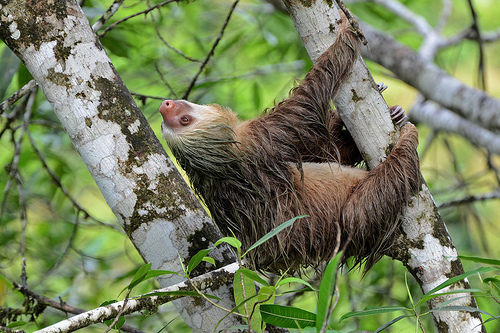
There are two species of two-toed sloth in S. America - Hoffman's (or Unau) found in the forested regions of northern S. America from Ecuador to Costa Rica, and Linnaeus (Choloepus didattylus) in Brazil.
Sloths are slow-moving, tree-dwelling animals that spend almost the whole of their lives hanging upside down from the branches of trees where the growth of algae on their hair provides the excellent greenish camouflage that makes them so difficult to spot.
When they are on the ground - perhaps due to a branch breaking - sloths can only move with difficulty.
They eat leaves and fruit. In addition to the two-toed sloths there are three species of three-toed sloth found in the rain forests of South America
Gorilla
Gorilla: Gorilla gorilla - Central West Africa
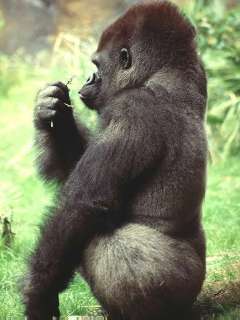 IUCN Red List status: Critically endangered
IUCN Red List status: Critically endangered
Gorillas live in the dense forest of tropical Africa where observation of their daily life becomes extremely difficult. Despite recent successful observations of the mountain gorilla in Zaire, much of their life in the wild remains a mystery.
There are two forms of gorilla. The lowland gorilla and the shaggy-coated mountain gorilla, which was only discovered in 1901.
Largest of all the living primates, an adult male will stand five and a half feet tall, with an arm spread of about 8 feet. It will weigh between 400 and 600lb, usually around 450 lb.
Despite its size and great strength, the gorilla is not an aggressive animal and will not usually attack unless its safety, or that of its family, is threatened. Vegetarian in diet, the gorilla leads an orderly family existence, spending much of the day consuming an intake of about 60lb of leaves and fruit!
Giant Anteater or Antbear – Central and South America
 In the tropical forests of Central and South America lives the giant anteater or antbear. The antbear can be seven feet in length from its long narrow snout to its bushy tail. It has an extremely long sticky tongue which darts from its snout as it licks up ants or termites, after it has torn open the insects' nest with its powerful curved claws.
In the tropical forests of Central and South America lives the giant anteater or antbear. The antbear can be seven feet in length from its long narrow snout to its bushy tail. It has an extremely long sticky tongue which darts from its snout as it licks up ants or termites, after it has torn open the insects' nest with its powerful curved claws.
Lesser Malay Chevrotain
 Lesser Malay Chevrotain: Tragus javanicus - S. Asia, Sumatra, Java, Borneo
Lesser Malay Chevrotain: Tragus javanicus - S. Asia, Sumatra, Java, Borneo
Standing only about 12 inches high at the shoulder, the chevrotain or mouse-deer is one of the smallest of all hoofed animals. Moving on pencil-thin legs, this little animal is a timid forest-dweller, feeding on flowers, fruits, vegetable matter and young leaves.
There are four species in this family; three live in Asia and one in Africa. The males have long upper canine teeth which protrude like fangs below the lips. Neither sex has horns or antlers. In Malay folklore the chevrotain is credited with great cunning (for how else could they evade the many different predators who hunt they?).
Siamang Gibbon
 Siamang Gibbon: Hylobates syndactylus - Malaya and Sumatra
Siamang Gibbon: Hylobates syndactylus - Malaya and Sumatra
IUCN Red List Status: Endangered
The siamang is the largest of the seven kinds of gibbon, all of which live in the rain forests of southern Asia. Gibbons are the smallest members of the Ape family and they spend most of their life up in the trees. Their arm over arm movement through the tree tops (known as brachiation) has resulted in the gibbon having very long arms and rather short legs. The saimang stands about 3 feet tall, but their arm-span may be 5 feet. Alone among the gibbons, the siamang has a huge vocal sac on the throat which helps to produce a very loud (and often blood curdling) call. Food consists of fruit, leaves, insects, young birds and eggs.
Ocelot
Ocelot: Leopardus pardalis - Central and South America
IUCN Red List Status: Least Concern

The ocelot, known in Mexico as the 'tigrillo' or 'little tiger', ranges through the forest regions of Central and South America from Texas in the north to Brazil and Paraguay in the south. It is the third largest of the South American cats after the jaguar and puma.
A fully grown male measures about four and a half feet from nose to tip of tail. Its beautiful spotted coat provides excellent camouflage in its forest home where it preys on a wide variety of animals, including small deer, agoutis, rats, peccaries, pacas, birds and some reptiles.
Sadly, it is much hunted by humans for its fur, and it is now seriously threatened. In areas where it is heavily hunted it has become a nocturnal animal, but elsewhere it can be seen in daylight. Although it can climb, the ocelot seems to hunt mainly on the forest floor.
Find out more about big cats in South America visit the South American Cats factsheet below.
Black Tree Kangaroo
 Black Tree Kangaroo: Dendrolagus ursinus - New Guinea
Black Tree Kangaroo: Dendrolagus ursinus - New Guinea
Nine species of tree kangaroo are listed; seven of them live in the dense rain forest of New Guinea, while the other two species inhabit the forests of northern Australia.
These animals are about the same size as a wallaby but differ in appearance and have much longer forelimbs and broader feet on the back legs.
Although the tree kangaroo may look rather slow and clumsy on the ground, it can climb quite quickly and with surprising agility. Unlike the majority of kangaroos, tree kangaroos are nocturnal animals, spending the daytime asleep in the trees and then coming down to ground level to spend the night on the forest floor.
Once again, despite their awkward shape for tree-dwelling, these animals can move well in trees and have been known to jump 20 feet from one tree to another. They descend trees tail first. Food consists of leaves and fruit.
Okapi
Okapi: Okapia johnstoni - Central Africa

IUCN Red List status: Endangered
Unknown to science until 1900, when it was discovered by H.H. Johnston, the Okapi is the only living relative of the giraffe and shares the family name Giraffidae.
This large animal has shorter legs than the giraffe and a shorter neck. It stands about 5ft (approximately 152 centimetres) at the shoulder and has a sleek purplish coloured coat with black and white bars on the legs. The head is giraffe-like, with a long muzzle, mobile lips and a long tongue for seizing foliage. The horns, which occur only in the males, are capped with a small polished tip which alone protrudes from the skin covering.
Okapis live in the densest parts of the rainforest, where they live a solitary existence or move in pairs. They feed on leaves of trees, shrubs and epiphytes. The colouring of the okapi renders it practically invisible even at a short distance.
Common Tree-Shrew
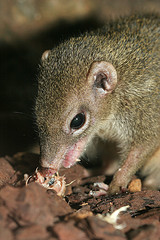 Common Tree-Shrew: Tupaia glis - S.Asia, Sumatra, Java, Borneo
Common Tree-Shrew: Tupaia glis - S.Asia, Sumatra, Java, Borneo
One of eighteen species of tree-shrew, this remarkable little animal was mistakenly identified as a shrew when it first came to the notice of zoologists. Subsequent investigation proved that this animal was not an insectivore at all, but a very primitive Primate, a member of the family which includes lemurs, monkeys, apes and man! The tree-shrew is a surviving relic from many millions of years ago.
About 14 inches in length, the animal is a skilful climber. Its food consists of a wide variety of plant and animal life.
Find out about other species of shrew all over the world with these factsheets Common Shrew and the Water Shrew both found in the UK.
Orangutan
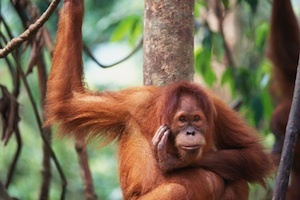 Orangutan: Pongo pygmaeus - Borneo and Sumatra
Orangutan: Pongo pygmaeus - Borneo and Sumatra
IUCN Red List status: Endangered
Although probably once represented on the mainland of Asia, the orang-utan population of about 5000 is confined to the islands of Borneo and Sumatra. While they are protected on both islands, the steady destruction of their forest territory poses a constant threat to their future.
The orang-utan is the second largest of the apes and the heaviest of all the tree-dwellers It is also the only great ape to be found outside Africa.
Heavily built, with a height of about four and a half feet and a weight of around 200lb, this ape is normally a rather lethargic mover. It has powerful arms and weak legs, and when on the ground it tends to use the arms as crutches, swinging the body along.
Despite their build and normally lethargic state, the orang-utans are capable of quite rapid movement should the need arise.
Seriously threatened, the orangutan needs full protection if it is going to survive. To find out more visit these factsheets - Orangutan, Rainforests, Palm Oil.
Malayan Pangolin
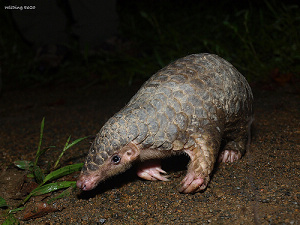 Malayan Pangolin: Manis javanica - South-east Asia
Malayan Pangolin: Manis javanica - South-east Asia
IUCN Red List status: Critically endangered
Pangolins, or scaly anteaters, are found in tropical Africa, south and south-east Asia. Pangolins are believed to be the world's most trafficked mammal.
There are four species in Africa and three in Asia. Although they resemble reptiles, these animals are mammals and their 'scales' are simply mammal hairs, flattened and modified into overlapping plates.
Like the armadillo, the pangolin rolls itself into a tight ball when threatened. The tail is prehensile and it permits the pangolin to hang from the branch of a tree when all four limbs are needed for other purposes such as an attack on a termites nest. Here, the powerful claws rip open the nest while the long sticky tongue mops up the termites. Termites and ants are the chief items of food. Pangolins are completely toothless. Little is known about their ancestry.
Javan Rhinoceros
Javan Rhinoceros: Rhinoceros sondaicus - S. Asia, Sumatra, Java
IUCN Red List status: Critically endangered
All five species of rhinoceros are threatened with extinction. The three Asian species are in great danger, and there are doubts that the rhinoceros can survive in Asia beyond the end of this century.
Like so many other animals, the Javan rhinoceros has suffered heavy persecution at the hand of man, and this once common species declined so rapidly in numbers that in the late 1960's it was thought there were only 24 survivors in the wild.
Thanks to careful conservation and protection the Javan rhinoceros has steadily increased in number over the past few years. It is estimated that there might be as many as 40-60 living in the dense forests of its range. It is the destruction of these forests that will threaten all the successful protection achieved through the efforts of many conservationists from several countries.
The Javan and Gt. Indian rhinoceros have only one horn, the Sumatran rhinoceros has two. The Sumatran is the smallest and hairiest of all the five species.
Slender Loris
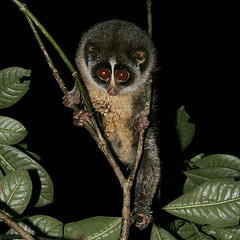
Slender Loris: Loris tadirgradus - South India and Ceylon
The family Lorisidae includes the slow-moving lorises of Asia, the equally slow angwantibo and potto of Africa, and the anything but slow-moving galagos or bushbabies found in southern and eastern Africa.
The slender loris lives in the jungles of southern India and Ceylon. It is a lightly built creature with long, spindly legs, slender body and large brilliant eyes. At one time the eyes of the slender loris were used as an ingredient of love potions!
It is a nocturnal animal, sleeping through the day and waking at sunset to move stealthily through the trees in search of its diet of insects, small birds, lizards and fruit.
Malayan Tapir
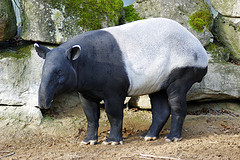 Malayan Tapir: Tapirus indicus - Malaysia
Malayan Tapir: Tapirus indicus - Malaysia
IUCN Red List status: Endangered
Tapir is the name given to the four surviving species of this large woodland mammal which form the family Tapiridae of the order Perissodactyla (odd-toed hooved animals). They are heavily built creatures with four front and three hind toes, a practically non-existent tail and with the nose and upper-lip forming a short flexible trunk.
Three of the four species live in Central and South America, but the fourth is to be found in the rainforests of Malaysia. The Malayan Tapir is easily recognised by his black and white colouring. This animal may stand 3and a half feet (approximately 1 metre) at the shoulder. It is shy, nocturnal and quite inoffensive, frequenting deep forests and keeping close to water and mud. Its diet is exclusively vegetarian. The young are spotted and striped with white.
To find out more about Tapir visit our Tapir Factsheet below.
Jaguar
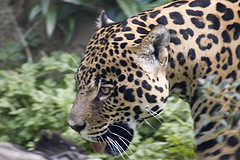 Jaguar: Panthera onca - Central and South America
Jaguar: Panthera onca - Central and South America
IUCN Red List status: Near Threatened
A fully grown male measuring up to 8ft from nose to tip of tail. It is a heavier animal than the leopards of Africa and Asia although similar in size. The jaguar differs from the leopard in having a more powerful head, shorter tail and shout stout legs. It is found on the edges of forests and often beside rivers from the southern United States to northern Argentina. Unlike most cats it seems to like water and obviously enjoys swimming. It will even fish with its paws. The diet of the jaguar includes capybaras, peccaries, deer, agoutis, tapir and fish. Heavily hunted by humans for its skin, the jaguar is steadily declining in numbers - and the destruction of the rain forests will speed this decline considerably.
Snakes
Snakes, like all reptiles, are cold-blooded animals which cannot adjust their body temperature internally. The constant warmth and humidity of tropical rain forests provide an ideal habitat where snakes can live without having to shelter from heat or cold.
Snakes of the rain forest are well adapted to an arboreal or tree-dwelling existence. Many have long thin bodies with angled scales on their bellies which help the snakes to grip branches. Other species have developed 'wings', enabling the snake to escape predators by gliding to another tree or the ground. Ground-dwelling snakes track by scent but in the trees the scent trail is broken whenever the prey crosses to another branch, so many tree-living species hunt by sight. Some have prehensile tails which can grip a branch firmly while the rest of the body moves on. Snakes are well camouflaged; the most common colours are green or brown to match leaves or bark, often with a twig-like or leaf-like pattern.
 Boas
Boas
Like the pythons of Africa and Asia the boas of South America kill by constriction. The largest boa is the anaconda, which averages 35ft in length and hunts along river banks. Other boas include the boa constrictor and the emerald tree boa.
Pythons
Pythons include many species of non-poisonous snakes which kill their prey, such as birds and small mammals, by constriction. The snake coils its long body round its victim and squeezes it to death. The largest python is the reticulated python of Asia; it can grow to 33 ft long and weigh 300 lb. The 3 ft long burrowing python of Africa is the smallest python.
Venomous Species
Poisonous snakes use their venom mainly for feeding rather than for defence. There are three main groups:
a) Rear-Fanged Snakes
The snakes in this group have the two or three rearmost teeth of the upper jaw enlarged and grooved for injecting venom. Few species are very poisonous and only two, both African tree snakes, are dangerous to humans.
b) Front Fixed-Fang Snakes
The fangs of these snakes are fixed at the front of the upper jaw. This group includes many deadly species, such as the mambas of Africa, the cobras of Africa and Asia, and the coral snakes of the New World.
c) Folding Fang Snakes
These snakes have a large pair of poison fangs at the front of the upper jaw. The fangs lie flat when not needed and are raised when the snake strikes. The group consists of the vipers and pit-vipers, for example the rattlesnakes and the bushmaster snake of Central and South America.
Credits
Image: Rainforest Animals by Joe Townsend
Information sourced from:
The IUCN Red List of Threatened Species (2015), Gorilla gorilla [online], Available from: http://www.iucnredlist.org/details/9404/0 [accessed 16/07/2015].
The IUCN Red List of Threatened Species (2015), Symphalangus syndactylus [online] Available from: http://www.iucnredlist.org/details/39779/0 [accessed 16/07/2015].
The IUCN Red List of Threatened Species (2015), Leopardus pardalis [online], Available from: http://www.iucnredlist.org/details/11509/0 [accessed 16/07/2015].
The IUCN Red List of Threatened Species (2015), Okapia johnstoni [online], Available from: http://www.iucnredlist.org/details/15188/0 [accessed 16/07/2015].
The IUCN Red List of Threatened Species (2015), Pongo pygmaeus [online], Available from: http://www.iucnredlist.org/details/17975/0 [accessed 16/07/2015].
The IUCN Red List of Threatened Species (2015), Manis javanica [online], Available from: http://www.iucnredlist.org/details/12763/0 [accessed 16/07/2015].
The IUCN Red List of Threatened Species (2015), Rhinoceros unicornis [online], Available from: http://www.iucnredlist.org/details/19496/0 [accessed 16/07/2015].
The IUCN Red List of Threatened Species (2015), Rhinoceros sondaicus [online], Available from: http://www.iucnredlist.org/details/19495/0 [accessed 16/07/2015].
The IUCN Red List of Threatened Species (2015), Diceros bicornis [online], Available from: http://www.iucnredlist.org/details/6557/0 [accessed 16/07/2015].
The IUCN Red List of Threatened Species (2015), Ceratotherium simum [online], Available from: http://www.iucnredlist.org/details/4185/0 [accessed 16/07/2015].
The IUCN Red List of Threatened Species (2015), Dicerorhinus sumatrensis [online], Available from: http://www.iucnredlist.org/details/6553/0 [accessed 16/07/2015].
The IUCN Red List of Threatened Species (2015), Tapirus inducus [online]. Available from: http://www.iucnredlist.org/details/21472/0 [accessed 16/07/2015].
The IUCN Red List of Threatened Species (2015), Panthera onca [online]. Available from: http://www.iucnredlist.org/details/15953/0 [accessed 16/07/2015].



 IUCN Red List status: Critically endangered
IUCN Red List status: Critically endangered In the tropical forests of Central and South America lives the giant anteater or antbear. The antbear can be seven feet in length from its long narrow snout to its bushy tail. It has an extremely long sticky tongue which darts from its snout as it licks up ants or termites, after it has torn open the insects' nest with its powerful curved claws.
In the tropical forests of Central and South America lives the giant anteater or antbear. The antbear can be seven feet in length from its long narrow snout to its bushy tail. It has an extremely long sticky tongue which darts from its snout as it licks up ants or termites, after it has torn open the insects' nest with its powerful curved claws. Lesser Malay Chevrotain: Tragus javanicus - S. Asia, Sumatra, Java, Borneo
Lesser Malay Chevrotain: Tragus javanicus - S. Asia, Sumatra, Java, Borneo Siamang Gibbon: Hylobates syndactylus - Malaya and Sumatra
Siamang Gibbon: Hylobates syndactylus - Malaya and Sumatra
 Black Tree Kangaroo: Dendrolagus ursinus - New Guinea
Black Tree Kangaroo: Dendrolagus ursinus - New Guinea
 Common Tree-Shrew: Tupaia glis - S.Asia, Sumatra, Java, Borneo
Common Tree-Shrew: Tupaia glis - S.Asia, Sumatra, Java, Borneo Orangutan: Pongo pygmaeus - Borneo and Sumatra
Orangutan: Pongo pygmaeus - Borneo and Sumatra Malayan Pangolin: Manis javanica - South-east Asia
Malayan Pangolin: Manis javanica - South-east Asia
 Malayan Tapir: Tapirus indicus - Malaysia
Malayan Tapir: Tapirus indicus - Malaysia Jaguar: Panthera onca - Central and South America
Jaguar: Panthera onca - Central and South America Boas
Boas